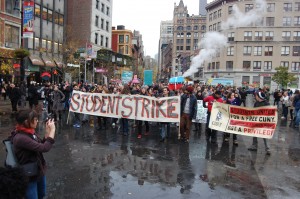
The Bonus Marchers' camp outside Washington D.C.
In Chapter 9 Meyer opens with the example of the Bonus Marchers of 1932, which I find particularly interesting being a member of Army ROTC. The basic idea behind the Bonus Marchers was for WWI veterans march to Washington D.C. and persuade the government to give them their monetary bonus for serving in the war immediately, instead of waiting till 1945, when it was originally scheduled to be paid. Their “Bonus Bill” was shot down in 1932, but in 1933 when Franklin Delano Roosevelt became president, they returned to protest again. Finally, by 1936 the Bonus Marchers’ continual protest was rewarded as Roosevelt agreed to pay the bonus ahead of schedule.
There are two things that I’d like to highlight in this story. First, that protest can affect policy. This is the theme of this chapter in looking at how exactly this happens. Second, this is an example of a social movement that fully achieved their goal. Unlike many of the social movements that we’ve looked at so far, the Bonus Marchers actually accomplished what they set out to do, and when they finished, they disbanded and went home. This will become important later on in this post.
Let’s look at the first topic, how exactly can protests affect policy? Meyer seems to point to a few different reasons, all leading up to the fact that in order to change policy, social movements have to go through the government in order to get their reforms enacted. Meyer talks about how the Bonus Marchers had contacts in government, and how they had their “Bonus Bill” heard in congress. But ultimately, everything has to go through government. Protests serve to gain attention, to spread the concerns to a wider audience, and then, once enough people are upset, the politicians have to do something about it.
Now why does this matter? What do we care that hundreds of people are camping out in Washington D.C. for a bonus that they’ll get paid eventually anyway? Meyer says that “When a mobilized effort demonstrates strength and commitment, it can make the current policy course untenable or make long-simmering ideas appear suddenly viable” (Meyer, 172). When enough people are upset it looks poorly for those in command. President Hoover had to explain why he didn’t favor helping the veterans when there was an unemployment problem already. The key seems to be numbers and persistence.
Finally, another way that I thought was key to this issue, and wasn’t really talked about very much in the chapter, was the fact that the Bonus Marchers had an achievable goal. It seems common sense that if you want to achieve your goal, you want to make your goal achievable. This is how I would critique some of the movements that just strive for “social equality” or to even out the wage dispersion like OWS wants. How is one ever going to fully achieve social equality? Or how can we ever make everyone have exactly equal pay? It just seems that sometimes smaller goals can get heard and made into policy more than the larger ones.
I’ve said a lot in this post that was hopefully provocative in some way. If you agree or disagree, please let me know by commenting. Thanks!

